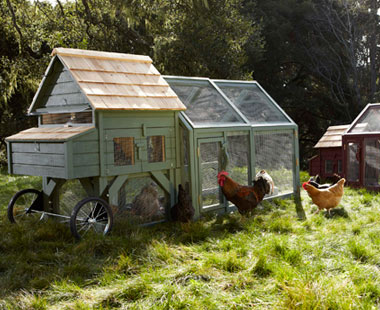Organic gardens! Canning! Sewing clothes! All the chickens! The modern rise of homesteading (of the hipster variety) has gripped the nation’s urban centers. It’s been kind of like this:
Self-sufficiency can’t be bad, though, right? At least when we’re aware of our motivations. Today at Bitch (based in Portland! hm!), Marianne Kirby takes a long look at modern homesteading through the lens of class. She pulls together the history of the 1862 Homestead Act, slave and victory gardens, and ’70s recession efforts at surviving tough times, providing context for how the lifestyle has been newly embraced by the petit bourgeoisie.
“For large portions of the poor and immigrant classes, homesteading skills are still survival skills,” she writes. “Can you really have a rebirth of something that never actually died out in the first place?”
Kirby calls out “capitalistic homesteading” and product branding. But this isn’t just about shopping and culture.
[I]t’s also about policy. My central Florida town recently implemented an urban-chicken pilot program due to a clamor of interest from young, middle-class community members. The program allows people to keep hens, but no roosters. Participants are allowed to raise chickens for eggs, but not for meat. This means urban homesteaders who want to raise eggs in fancy coops have won out — but anyone who needs to raise chickens for subsistence reasons suffers, and is subject to fines and seizure if they get caught.
Governmental limitation of the “wrong” kind of homesteading can be seen elsewhere. In 2011, Denise Morrison’s garden was chopped down by Tulsa, Oklahoma, officials who claimed it violated city ordinances. Morrison grew more than 100 edible and medicinal plants in her yard. Subsistence gardens are more about function than design; they aren’t always pretty, and Morrison wasn’t raising organic fruit and vegetables in neat rows of raised beds. Despite a stay issued by local courts, officials removed every last one of her plants. Unemployed and without health insurance, Morrison had relied on her garden for food and medicine. “They basically took away my livelihood,” she told Tulsa’s KOTV.
“Homesteading, by necessity, isn’t sexy,” says Genny Charet, who blogs at badmamagenny.com. “If it can’t be packaged and spoon-fed to one identifiable demographic, it loses its platform. And how do you package and sell ‘I don’t have enough money for Advil when I have my period so I grow raspberry leaf instead?’ It’s not fair or right, but then, mainstream media is not an avenue that can be counted on to advance the interests of marginalized populations.” Cases like Morrison’s are common; widespread media coverage of them is not.
While poor people of color, like Denise Morrison, steadily practice survival, the cool kids are lauded for their revolutionary interest in a gentrified version of subsistence farming.
Oakland, Calif., where I live, is considered one of the grittier ground zeroes for this movement, but it often butts up against a large low-income population of color, many of whom live on toxic soil that they can’t farm without shelling out for the pricey remediation efforts that hipster homesteaders can afford. Recently at a party a friend showed me a picture he snapped in Oakland’s Chinatown of a neighbor hanging their dead ducks out to cure on a street-facing side of a fence. That neighbor was in all likelihood not a homesteady hipster, but was just living a life of tradition and necessity.
Now I count the days until I see some dead ducks hanging on a fence next to the coffee shop/workspace that homebrews its own kombucha. So long as everyone’s duck is allowed on the fence, right? (Fake kind for me, thanks.)


